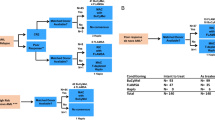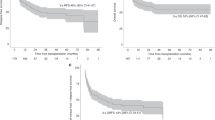Abstract
Myeloablative conditioning continues to be employed in hematopoietic stem cell transplantation among patients with pediatric transplant indications. Fractionated TBI (fTBI) remains, with its considerable anti-leukemic potential, the cornerstone of conditioning in the most common of pediatric indications, ALL in its first, second or subsequent remission despite its well-established long-term sequelae. The feasibility of chemotherapy-only regimens has been established and these regimens widely employed in other pediatric indications, for example, in ALL below the age of 2 years, AML, myelodysplasias or severe aplastic anemia. Conditioning regimens are being modified with data accumulating on the role of, for example, pre-transplant residual disease, advanced HLA-typing or haploidentical transplantations in the pediatric setting.
This is a preview of subscription content, access via your institution
Access options
Subscribe to this journal
Receive 12 print issues and online access
$259.00 per year
only $21.58 per issue
Buy this article
- Purchase on Springer Link
- Instant access to full article PDF
Prices may be subject to local taxes which are calculated during checkout
Similar content being viewed by others
References
Green A, Clarke E, Hunt L, Canterbury A, Lankester A, Hale G et al. Children with acute lymphoblastic leukemia who receive T-cell-depleted HLA mismatched marrow allografts from unrelated donors have an increased incidence of primary graft failure but a similar overall transplant outcome. Blood 1999; 94: 2236–2246.
Balduzzi A, Gooley T, Anasetti C, Sanders JE, Martin PJ, Petersdorf EW et al. Unrelated donor marrow transplantation in children. Blood 1995; 86: 3247–3256.
Woolfrey AE, Anasetti C, Storer B, Doney K, Milner LA, Sievers EL et al. Factors associated with outcome after unrelated marrow transplantation for treatment of acute lymphoblastic leukemia in children. Blood 2002; 99: 2002–2008.
Zecca M, Pession A, Messina C, Bonetti F, Favre C, Prete A et al. Total body irradiation, thiotepa, and cyclophosphamide as a conditioning regimen for children with acute lymphoblastic leukemia in first or second remission undergoing bone marrow transplantation with HLA-identical siblings. J Clin Oncol 1999; 17: 1838–1846.
Bleakley M, Shaw PJ, Nielsen JM . Allogeneic bone marrow transplantation for childhood relapsed acute lymphoblastic leukemia: comparison of outcome in patients with and without a matched family donor. Bone Marrow Transplant 2002; 30: 1–7.
Bunin N, Carston M, Wall D, Adams R, Casper J, Kamani N et al. Unrelated marrow transplantation for children with acute lymphoblastic leukemia in second remission. Blood 2002; 99: 3151–3157.
Davies SM, Ramsay NK, Klein JP, Weisdorf DJ, Bolwell B, Cahn JY et al. Comparison of preparative regimens in transplants for children with acute lymphoblastic leukemia. J Clin Oncol 2000; 18: 340–347.
Schrauder A, Reiter A, Gadner H, Niethammer D, Klingebiel T, Kremens B et al. Superiority of allogeneic hematopoietic stem-cell transplantation compared with chemotherapy alone in high-risk childhood T-cell acute lymphoblastic leukemia: results from ALL-BFM 90 and 95. J Clin Oncol 2006; 24: 5742–5749.
Marks DI, Forman SJ, Blume KG, Perez WS, Weisdorf DJ, Keating A et al. A comparison of cyclophosphamide and total body irradiation with etoposide and total body irradiation as conditioning regimens for patients undergoing sibling allografting for acute lymphoblastic leukemia in first or second complete remission. Biol Blood Marrow Transplant 2006; 12: 438–453.
Balduzzi A, Valsecchi MG, Uderzo C, De Lorenzo P, Klingebiel T, Peters C et al. Chemotherapy versus allogeneic transplantation for very-high-risk childhood acute lymphoblastic leukaemia in first complete remission: comparison by genetic randomisation in an international prospective study. Lancet 2005; 366: 635–642.
Gaynon PS, Harris RE, Altman AJ, Bostrom BC, Breneman JC, Hawks R et al. Bone marrow transplantation versus prolonged intensive chemotherapy for children with acute lymphoblastic leukemia and an initial bone marrow relapse within 12 months of the completion of primary therapy: Children's Oncology Group study CCG-1941. J Clin Oncol 2006; 24: 3150–3156.
Peters C, Schrauder A, Schrappe M, von Stackelberg A, Stary J, Yaniv I, et al., BFM Study Group, the IBFM-Study Group and the Paediatric Disease Working Party of the EBMT. Allogeneic haematopoietic stem cell transplantation in children with acute lymphoblastic leukaemia: the BFM/IBFM/EBMT concepts. Bone Marrow Transplant 2005; 35 (Suppl 1): S9–11.
Eapen M, Raetz E, Zhang MJ, Muehlenbein C, Devidas M, Abshire T et al. Outcomes after HLA-matched sibling transplantation or chemotherapy in children with B-precursor acute lymphoblastic leukemia in a second remission: a collaborative study of the Children's Oncology Group and the Center for International Blood and Marrow Transplant Research. Blood 2006; 107: 4961–4967.
Eapen M, Rubinstein P, Zhang MJ, Camitta BM, Stevens C, Cairo MS et al. Comparable long-term survival after unrelated and HLA-matched sibling donor hematopoietic stem cell transplantations for acute leukemia in children younger than 18 months. J Clin Oncol 2006; 24: 145–151.
Neudorf S, Sanders J, Kobrinsky N, Alonzo TA, Buxton AB, Gold S et al. Allogeneic bone marrow transplantation for children with acute myelocytic leukemia in first remission demonstrates a role for graft versus leukemia in the maintenance of disease-free survival. Blood 2004; 103: 3655–3661.
Nemecek ER, Gooley TA, Woolfrey AE, Carpenter PA, Matthews DC, Sanders JE . Outcome of allogeneic bone marrow transplantation for children with advanced acute myeloid leukemia. Bone Marrow Transplant 2004; 34: 799–806.
Locatelli F, Nollke P, Zecca M, Korthof E, Lanino E, Peters C et al. Hematopoietic stem cell transplantation (HSCT) in children with juvenile myelomonocytic leukemia (JMML): results of the EWOG-MDS/EBMT trial. Blood 2005; 105: 410–419.
Yusuf U, Frangoul HA, Gooley TA, Woolfrey AE, Carpenter PA, Andrews RG et al. Allogeneic bone marrow transplantation in children with myelodysplastic syndrome or juvenile myelomonocytic leukemia: the Seattle experience. Bone Marrow Transplant 2004; 33: 805–814.
Socie G, Devergie A, Girinski T, Piel G, Ribaud P, Esperou H et al. Transplantation for Fanconi's anaemia: long-term follow-up of fifty patients transplanted from a sibling donor after low-dose cyclophosphamide and thoraco-abdominal irradiation for conditioning. Br J Haematol 1998; 103: 249–255.
Flowers ME, Zanis J, Pasquini R, Deeg HJ, Ribeiro R, Longton G et al. Marrow transplantation for Fanconi anaemia: conditioning with reduced doses of cyclophosphamide without radiation.see comment. Br J Haematol 1996; 92: 699–706.
Guardiola P, Pasquini R, Dokal I, Ortega JJ, van Weel-Sipman M, Marsh JC et al. Outcome of 69 allogeneic stem cell transplantations for Fanconi anemia using HLA-matched unrelated donors: a study on behalf of the European Group for Blood and Marrow Transplantation. Blood 2000; 95: 422–429.
Wagner JE, Eapen M, MacMillan ML, Harris RE, Pasquini R, Boulad F et al. Unrelated donor bone marrow transplantation for the treatment of Fanconi anemia. Blood 2007; 109: 2256–2262.
Kroger N, Zabelina T, Renges H, Kruger W, Kordes U, Rischewski J et al. Long-term follow-up of allogeneic stem cell transplantation in patients with severe aplastic anemia after conditioning with cyclophosphamide plus antithymocyte globulin. Ann Hematol 2002; 81: 627–631.
Urban C, Benesch M, Sykora KW, Schwinger W, Lackner H . Non-radiotherapy conditioning with stem cell transplantation from alternative donors in children with refractory severe aplastic anemia. Bone Marrow Transplant 2005; 35: 591–594.
Bunin N, Aplenc R, Iannone R, Leahey A, Grupp S, Monos D et al. Unrelated donor bone marrow transplantation for children with severe aplastic anemia: minimal GVHD and durable engraftment with partial T cell depletion. Bone Marrow Transplant 2005; 35: 369–373.
Antoine C, Muller S, Cant A, Cavazzana-Calvo M, Veys P, Vossen J et al. Long-term survival and transplantation of haemopoietic stem cells for immunodeficiencies: report of the European experience 1968–1999.see comment. Lancet 2003; 361: 553–560.
Peters C, Steward CG . National Marrow Donor Program. International Bone Marrow Transplant Registry. Working Party on Inborn Errors, European Bone Marrow Transplant Group. Hematopoietic cell transplantation for inherited metabolic diseases: an overview of outcomes and practice guidelines. Bone Marrow Transplant 2003; 31: 229–239.
Souillet G, Guffon N, Maire I, Pujol M, Taylor P, Sevin F et al. Outcome of 27 patients with Hurler's syndrome transplanted from either related or unrelated haematopoietic stem cell sources. Bone Marrow Transplant 2003; 31: 1105–1117.
Klingebiel T, Handgretinger R, Lang P, Bader P, Niethammer D . Haploidentical transplantation for acute lymphoblastic leukemia in childhood. Blood Rev 2004; 18: 181–192.
Marks DI, Khattry N, Cummins M, Goulden N, Green A, Harvey J et al. Haploidentical stem cell transplantation for children with acute leukaemia. Br J Haematol 2006; 134: 196–201.
Bacigalupo A . Antilymphocyte/thymocyte globulin for graft versus host disease prophylaxis: efficacy and side effects. Bone Marrow Transplant 2005; 35: 225–231.
Vettenranta K, Saarinen-Pihkala UM, Cornish J, Steward C, Pamphilon D, Hovi L et al. Pediatric marrow transplantation for acute leukemia using unrelated donors and T-replete or -depleted grafts: a case-matched analysis. Bone Marrow Transplant 2000; 25: 395–399.
Myers GD, Krance RA, Weiss H, Kuehnle I, Demmler G, Heslop HE et al. Adenovirus infection rates in pediatric recipients of alternate donor allogeneic bone marrow transplants receiving either antithymocyte globulin (ATG) or alemtuzumab (Campath). Bone Marrow Transplant 2005; 36: 1001–1008.
Rocha V, Sanz G, Gluckman E, Eurocord and European Blood and Marrow Transplant group. Umbilical cord blood transplantation. Curr Opin Hematol 2004; 11: 375–385.
Acknowledgements
I thank the members of the Board of the Paediatric Diseases Working Party of the EBMT as well as Drs Carsten Heilmann (Rigshospitalet, Copenhagen, Denmark) and Jacek Winiarski (Karolinska Sjukhuset, Stockhlm, Sweden) for their valuable contribution in the preparation of this paper.
Author information
Authors and Affiliations
Consortia
Corresponding author
Additional information
Conflict of interest
The author declared no financial interests.
Rights and permissions
About this article
Cite this article
Vettenranta, K., on behalf of the EBMT Paediatric Working Party. Current European practice in pediatric myeloablative conditioning. Bone Marrow Transplant 41 (Suppl 2), S14–S17 (2008). https://doi.org/10.1038/bmt.2008.47
Published:
Issue Date:
DOI: https://doi.org/10.1038/bmt.2008.47
Keywords
This article is cited by
-
Long-term health outcomes in survivors of childhood AML treated with allogeneic HSCT: a NOPHO–AML Study
Bone Marrow Transplantation (2019)
-
Treosulfan-based conditioning regimens for allogeneic HSCT in children with acute lymphoblastic leukaemia
Annals of Hematology (2015)
-
Impact on long-term OS of conditioning regimen in allogeneic BMT for children with AML in first CR: TBI+CY versus BU+CY: a report from the Société Française de Greffe de Moelle et de Thérapie Cellulaire
Bone Marrow Transplantation (2014)
-
Total Body Irradiation (TBI) in Pediatric Patients
Strahlentherapie und Onkologie (2010)



